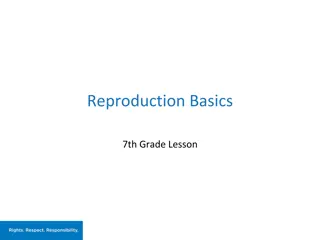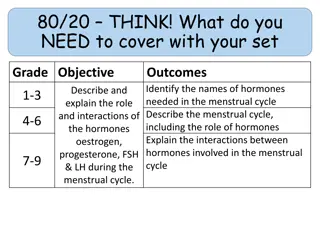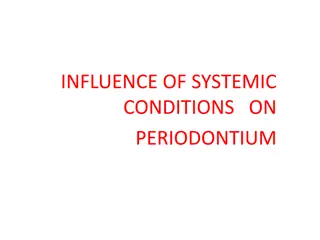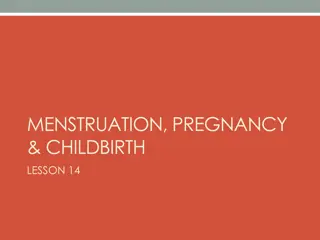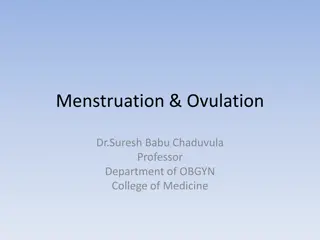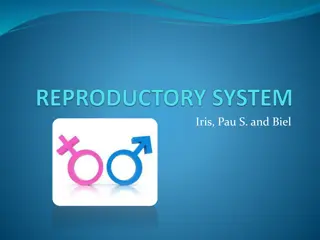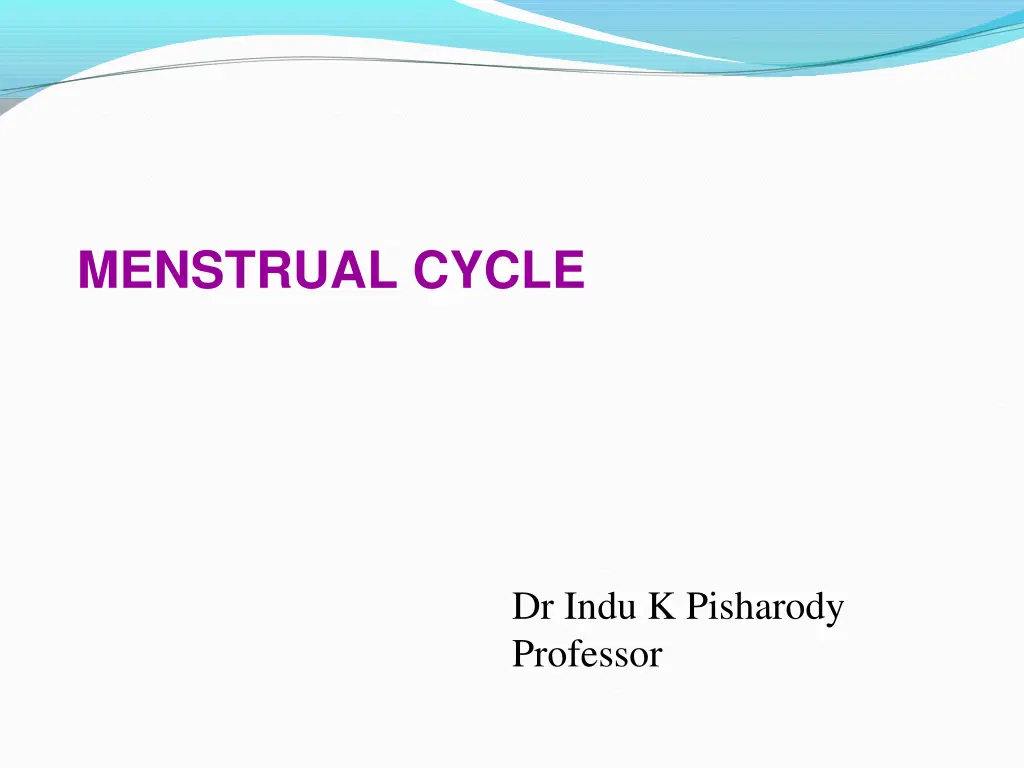
Understanding the Menstrual Cycle and Ovarian Function
Explore the menstrual cycle, from menarche to menopause, and the ovarian cycle's role in reproduction. Learn about normal menstruation characteristics, hormonal axis, and ovarian follicular development.
Download Presentation

Please find below an Image/Link to download the presentation.
The content on the website is provided AS IS for your information and personal use only. It may not be sold, licensed, or shared on other websites without obtaining consent from the author. If you encounter any issues during the download, it is possible that the publisher has removed the file from their server.
You are allowed to download the files provided on this website for personal or commercial use, subject to the condition that they are used lawfully. All files are the property of their respective owners.
The content on the website is provided AS IS for your information and personal use only. It may not be sold, licensed, or shared on other websites without obtaining consent from the author.
E N D
Presentation Transcript
MENSTRUAL CYCLE Dr Indu K Pisharody Professor
Introduction Typically, reproductive age (15-45) should menstruate every 28 days or so unless she's pregnant or moving into menopause. The menstrual cycle is essential for the production of eggs, and for the preparation of the uterusfor pregnancy a woman of childbearing age or
Definition: Menstruation caused by shedding of progestational endometrium. It occurs between menarche andmenopause means cyclic uterine bleeding
Characteristics of normalmenstruation 1-Menarche: 10-16 years. average 13years. 2-Duration: 2-7 days (<2days is hypomenorrhea and >7 days is menorrhagia 3-Amount: 30-80 ml, >80 ml. is menorrhagia and < 30 ml. is hypomenorrhea.
4-Normally menstrual blood doesnt coagulate as a result of secretion of fibrinolysin enzyme (plasmin) secreted by the endometrium. 5-Menstrual molimina refers to mild symptoms of 7- 10 days before menstruation and relieved once menstruation occurs (premenstrual syndrome). it is
The hypothalamic-pituitary-ovarian axis: There are two main components of the menstrual cycle, the changes that happen in the ovaries in response to pituitary hormones (the ovarian cycle) and the variations that take place in the uterus,but it is important to remember that both cycles work together simultaneously to produce the menstrual cycle. Changes in cervical mucus also take place during the course of the menstrualcycle.
OvarianCycle: The ovarian cycle refers to Periodic changes that occur in the ovary every month during the reproductive life. Cyclical changes in the ovaries occur in response to two anterior pituitary hormones: Follicle-stimulating hormone(FSH) Luteinizing hormone (LH).
Ovarian follicular development Fetus:6-7 million in 20 wks. At birth:1-2 million At puberty:300,000 Release during ovulation:400-500 At menopause: rare
The changes that occur in the ovary during each cycle canbe divided into threephases: 1)Follicular phase (day 1-13) 2) Ovulatory phase(day13-15)** 3)The luteal phase (day15-28). These phases run in parallel with the phases of the uterine cycle and together comprise the menstrualcycle.
At the beginning of each menstrual cycle, the hypothalamus secretes -----< GnRh in a pulsatile manner to stimulate ----< ant. Pit. gland to secretes ------< FSH &LH. FSH is responsible for the growth of several primary follicle The encompasses days 1to 13of a 28-daycycle. follicular phase is controlled by FSH,
only one follicle on one of the ovaries reaches maturity (graafian follicle) which secretes oestrogen. Estrogen has negative feedback on the pituitary to stop FSH Estrogen causes the uterine lining (endometrium) to grow thicker
The estrogen peak stimulates secretion of LH. The LH peak leads to: The follicle to burst open, releasing the mature process called (ovulation). Luteum formation. Ovulation occurs on day 14 of a 28-day cycle. ovum into the abdominal cavity a and corpus Note : High estrogen also suppress FSH secretion so no furtherfollicles grow
After ovulation, LH levels remain elevated and cause the remnants of the follicle to develop into a yellow body called the corpus luteum. + In addition to producing oestrogen, the corpus luteum secretes a hormone called progesterone.
WHEN progesterone reaches a high level it inhibits the secretion degeneration of the fertilization does not take place), and so oestrogen and progesterone separation of (menstruation) & hypothalamus to secrete more GnRH, a new cycle is started. of LH luteum leads (If corpus drop & the endometrium stimulates the
II -UterineCycle: The uterine cycle refers to the changes that are found in the uterine lining of the uterus. These changes come about in response to the ovarian hormones estrogen and progesterone. There are 3 phases to this cycle: 1. Menstrual, 2. Proliferative, 3. Secretory .
1-MenstrualPhase Day 1 of the menstrual cycle is marked by the onset of menstruation. During the menstrual phase of the uterine cycle, the uterine lining is shed because of low levels of progesterone & estrogen. At the same time, a follicle is beginning to develop and starts producing. The menstrual phase ends when the menstrual period stops on approximately day5. Duration 1-5days
2-ProliferativePhase When endometrium begins to regenerate. Estrogen stimulates blood vessels to develop. The blood vessels in turn bring nutrients and oxygen to the uterine lining, and it begins to grow and become thicker. The proliferative phase ends with ovulation on day 14. estrogen levels are high enough, the
3-SecretoryPhase After produce progesterone. This hormonecauses the uterine lining to become rich in nutrients in preparation for pregnancy. Estrogen levels also remain high so that thelining is maintained. If pregnancy doesn t occur, the ovulation, the corpus luteum begins to corpus luteum gradually degenerates.
. On days 27 and 28, estrogen and progesterone levels fall because the corpus luteum is no longer producing them. Without these hormones to maintain the blood vessel network, the uterine lining becomes ischemic. When the lining start slough, the woman has come full cycle and is once again at day 1of the menstrual cycle.
Cervical MucusChanges: Changes course of the menstrual cycle. Some women use in cervical mucus takes place over the these characteristics to help determine ovulation is likely menstrual phase the mucus. As the prolipherative phase begins, the cervix begins to produce a tacky, crumbly type of mucus that is yellow or white. when the to happen. cervix doesn t During produce
As the time of ovulation becomes near, the mucus becomes progressively clear, thin and lubricative, with the properties of raw egg white. At the peak of fertility(i.e., during ovulation), distensible, stretchable called spinbarkheit. After ovulation the mucus becomes scanty, thick, and opaque. the mucus has a
Fig. 34-1: Events of the Menstrual Cycle Hypothalamus secretes GnRH Anterior pituitary secretes LH and FSH Proliferative phase Follicular stage Graafian follicle stimulated Ovaries release estrogen High estrogen levels inhibit FSH secretion, stimulate LH production LH makes mature follicle burst: ovulation Secretory phase LH makes corpus luteum secrete progesterone Luteal stage Progesterone inhibits LH secretion Decreased LH and FSH levels Corpus luteum atrophies, stops making progesterone Decreased estrogen and progesterone levels stimulate GnRH secretion Menstrual phase
CYCLE ABNORMALITIES Anovulation Hypomenorrhea Metrorrhagia Oligomenorrhea Amenorrhea Polymenorrhea
Term Description Amenorrhea Noperiods Dysmenorrhea Painfulperiods Hypomenorrhea Regular menstruation occurring at normal intervals, but with minimal blood loss. Menorrhagia, hypermenorrhea or Regular menstruation occurring at normal intervals, but with heavy blood loss. Menometrorrhagia Prolonged bleeding that occurs at irregular intervals Menometrorrhagia (meno = prolonged, metro = short, rrhagia = excessive flow/discharge). Metrorrhagia Bleeding that occurs at frequent, irregular intervals(spotting) Oligomenorrhea Abnormal prolongation of the intermenstrual period, every five weeks or more. Polymenorrhea Regular menstruation, which is normal in amount but it, occurs at short intervals, three weeks or less. Postmenopausal bleeding Bleeding that occurs after menopause. Premenstrual (PMS) syndrome Physical and psychological symptoms that occur before the start of a period. Primary amenorrhea No periods ever starting (at puberty). Secondaryamenorrhea Periods that hasstopped.



